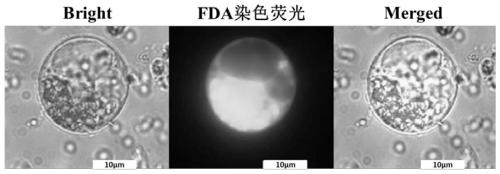Preparation and conversion method of soybean protoplasts
A protoplast, soybean technology, applied in the field of plant genetic engineering, to achieve accurate transformation, improve the transformation rate, and solve the effects of difficult transformation
- Summary
- Abstract
- Description
- Claims
- Application Information
AI Technical Summary
Problems solved by technology
Method used
Image
Examples
Embodiment 1
[0041] Induction of soybean embryogenic callus and preparation of protoplasts:
[0042] 1) Pick the plump young pods of soybeans 14 days after flowering, rinse them with sterile water 3-4 times, and remove the impurities on the surface;
[0043] 2) The young pods are completely soaked in 20% sodium hypochlorite solution, sterilized by shaking on a shaker (180r / min, 25)°C for 20 minutes, and rinsed with sterile water 2-3 times;
[0044] 3) peel off the immature embryos of the immature pods with sterilized tweezers and scalpel, and remove the seed coat;
[0045] 4) Place the adaxial end of the immature embryo in D40 medium at constant temperature (25-26°C, 16h / 8h, 300μmol·m -2 ·s -1 ) induced for 30 days;
[0046] 5) selecting somatic embryos with a diameter of about 3 mm and transferring them to D20 medium for 20 days;
[0047] 6) After the somatic embryo grows to a size of 0.8-1 mm, it is transferred to a freshly prepared D20 medium for subculture for 5 times to obtain an ...
Embodiment 2
[0053] Preparation of soybean leaf protoplasts:
[0054] 1) Select the first three compound leaves after 14 days of soybean germination, and wash the surface of the leaves with sterile water to remove impurities;
[0055] 2) Cut the blade into thin strips of 0.5 mm with a scalpel and tweezers so as to fully contact with the enzyme solution, and take about 0.2 g for each sample;
[0056] 3) Add 0.2g strip leaves to 5mL mixed enzymolysis solution, seal and enzymolyze for 5h under the conditions of dark, temperature 25-26, ℃ 50r·min-1;
[0057] 4) Filter the enzymatic solution with a nylon mesh cell sieve (200 mesh), transfer the filtrate to a centrifuge tube at 800r min -1 Centrifuge for 5 minutes, draw the supernatant as carefully as possible, add 10mL W5 solution to wash twice, and obtain the crude and pure protoplasts;
[0058] 5) Add 5mL of W5-23% solution to the crude protoplasts, 800r·min -1 Centrifuge for 5 minutes, carefully suck out the protoplast band as much as pos...
Embodiment 3
[0062] Transformation of soybean leaf protoplasts:
[0063] 1) Adjust the density of leaf protoplast suspension to 5×10 with W5 solution 6 cells / mL, placed on ice for 1 h, after the protoplasts settled at the bottom of the test tube, carefully suck up the supernatant as much as possible with a pipette gun, resuspend the protoplasts with MMG suspension, and adjust the density to 2.5×106 / mL, stand at room temperature;
[0064] 2) Prepare 6-10 sterile centrifuge tubes, add 0.1mL of the protoplast resuspension, 0.01mL of the plasmid, and 0.11mL of a 30% PEG4000 solution to each test tube, wherein the concentration of the plasmid is 1.5 μg / μL, immediately invert and mix, and stand at room temperature for 10 minutes;
[0065] 3) Then add 0.4mL W5 solution to each centrifuge tube, gently invert the centrifuge tube to mix to terminate the transformation reaction, centrifuge at 200g / min for 2min at room temperature, and remove the supernatant;
[0066] 4) The protoplasts were resu...
PUM
 Login to View More
Login to View More Abstract
Description
Claims
Application Information
 Login to View More
Login to View More - R&D
- Intellectual Property
- Life Sciences
- Materials
- Tech Scout
- Unparalleled Data Quality
- Higher Quality Content
- 60% Fewer Hallucinations
Browse by: Latest US Patents, China's latest patents, Technical Efficacy Thesaurus, Application Domain, Technology Topic, Popular Technical Reports.
© 2025 PatSnap. All rights reserved.Legal|Privacy policy|Modern Slavery Act Transparency Statement|Sitemap|About US| Contact US: help@patsnap.com


